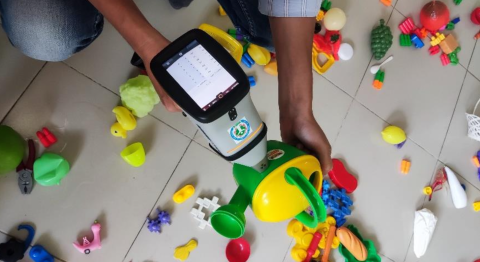FOLLOW-UP STUDY ON BLOOD LEAD LEVELS IN SOME VIETNAMESE CHILDREN (2022)

REPORT SUMMARY
ON EVALUATION OF BLOOD LEAD LEVELS AND IDENTIFICATION OF SOME RISK FACTORS FOR LEAD EXPOSURE OF CHILDREN IN TAN HIEP COMMUNE, LONG THANH DISTRICT, DONG NAI PROVINCE
In 2022, the Research Centre for Gender, Family and Environment in Development (CGFED), in collaboration with the Faculty of Environmental and Community Health, the Institute of Occupational and Environmental Health (NIOEH), conducted a study on blood lead levels of preschool children.This is a follow up on the 2021 study which found lead concentrations in the living environment (wall paint and toys) of over 20 children and found their blood lead levels (BLLs) in the range of 5.26 µg/dL to 20.72 µg/dL – 1.5 to 6.5 times higher than the United States Centers for Disease Control and Prevention (US CDC)’s reference value (3.5 µg/dL) to determine the correlation between the child's blood lead content and the lead content in paints within the children’s surrounding environment and plastic toys from which they get exposed from lead.
Methodology:
Blood samples: 20 blood samples from 20 children whose blood lead concentrations in the 2021 study were greater than 5 µg/dL; the children were selected among 48 children who were part of the initial study in 2021.
Interviewees: Directly interview 20 children's parents/guardians about the risk factors for lead exposure and the children's living habits at school.
Measurement of lead content in the plastic toys and wall paints: Use portable X-ray fluorescence (XRF) equipment to quickly measure lead content in wall paints, in painted toys, and in daily playground areas of children at preschools and homes.
Results:
- The average BLLs among children participating in this study is 4.75 µg/dL; the lowest is 3.59 µg/dL and the highest is 9.77 µg/dL. All children had BLLs higher than the US CDC recommended threshold (3.5 µg/dL), of which 65% of children had BLLs ranging from 3.5 µg/dL to 5.0 µg/dL, and 35% of children had BLLs ranging from 5.0 µg/dL to a little less than 10.0 µg/dL.
- The average BLLs among children in 2022 (4.75 µg/dL) has decreased compared to 2021 (5.96 µg/dL).
- Results of the analysis show that children exposed to objects containing lead at home had higher BLLs (4.85 µg/dL) than those who had no exposures to lead (4.68 µg/dL).
- The high lead levels in children’s blood may suggest that children may have been exposed to other sources of lead (i.e., drinking water, food, or other environmental factors) that were not included in the study. Therefore, more intensive research is needed to clarify other causes of lead exposure.
| Attachment | Size |
|---|---|
| 901.45 KB | |
| 1.69 MB |
